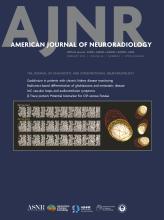This article requires a subscription to view the full text. If you have a subscription you may use the login form below to view the article. Access to this article can also be purchased.
Abstract
BACKGROUND AND PURPOSE: This study investigates the practicality and utility of the “outline sign,” which refers to the thin curvilinear hyperenhancing line that may be seen along the margin of a meningioma on a spin-echo postcontrast T1-weighted image. For cases in which the differential diagnosis may include other tumors, visualization of the outline sign may help to increase the diagnostic confidence for a meningioma. Therefore, in the temporal bone region such as the cerebellopontine angle or jugular foramen, where differential considerations may include a schwannoma or paraganglioma, we additionally investigated whether the outline sign may be observed in these nonmeningioma lesions.
MATERIALS AND METHODS: A total of 39 clinical MRIs of meningiomas, schwannomas, and paragangliomas with confirmed histopathologic data were studied retrospectively. Two experienced head and neck radiologists independently assessed for the presence or absence of an outline sign and subsequently formed a consensus opinion while blinded to patient information and histopathologic data. Interreader reliability was assessed by Cohen κ statistics. Simple bivariate comparisons were performed on the consensus opinions to assess for statistical differences in presence of the sign in meningiomas versus schwannomas and paragangliomas. Sensitivity, specificity, and accuracy of the sign with respect to identifying an underlying meningioma were calculated.
RESULTS: Both readers displayed identical opinions in assessment of the outline sign in 34 of the 39 cases (87%), including 13 of the 14 meningiomas (93%), with substantial agreement (Cohen κ of 0.74). The outline sign was present in 12 of 14 meningiomas (86%), which was significantly greater in frequency compared with schwannomas (3 of 22, 14%) and paragangliomas (1 of 3, 33%). The outline sign demonstrated high sensitivity (86%), specificity (84%), and accuracy (85%) in identifying an underlying meningioma.
CONCLUSIONS: The outline sign can serve as a useful tool for diagnosing meningiomas. It may help distinguish meningiomas from other enhancing tumors, for example schwannomas and paragangliomas in the temporal bone region.
- © 2025 by American Journal of Neuroradiology












